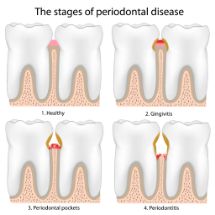
Gum disease, also called periodontal disease, affects an estimated 65 million people in the U.S. Despite its prevalence, many people have questions about gum disease and aren’t sure what the causes, consequences, or available treatments are. When it comes to your health, knowledge is power! Keep reading to get answers to the top 5 periodontal disease FAQ’s and find out how to minimize the risks from this common condition.
1. What Are the Dangers of Gum Disease?
Gum disease poses serious risks to your oral and overall health. First, it’s the leading cause of tooth loss, which surprises many people. This occurs because the gums support the teeth and keep them in place, and as these structures become damaged, the teeth can become loose and fall out.
Second, there’s a strong mouth-body connection, and many studies have been done showing that gum disease increases the risk of all of the following:
- Heart disease
- Certain types of cancer
- Stroke
- Dementia and Alzheimer’s disease
- Diabetes
- Pregnancy complications
2. What Causes Gum Disease?
There are multiple potential causes of gum disease and, in many cases, there’s more than one factor involved at a time. Here are some of the most common causes:
- Poor oral hygiene
- Heredity
- Smoking
- Diabetes
3. What Are the Signs of Gum Disease?
The early stages of gum disease include symptoms like red, tender, puffy, or bleeding gums. As it becomes more advanced, you might notice more severe bleeding, loose teeth, chronic bad breath, or pus under the gumline.
If you have any of these symptoms, schedule a checkup to have your gums examined. There are great treatments, but they’re more effective when done early on.
4. How Is Gum Disease Treated?
This condition can’t be cured, but with effective gum disease treatment, it can be managed to prevent it from getting worse. First, your dentist may recommend a “deep cleaning,” also called scaling and root planing. This special cleaning is usually done in 2-4 visits and thoroughly removes tartar and bacteria from under the gumline. The roots of the teeth are also smoothed to prevent bacteria from re-accumulating.
You can also have an antibiotic gel placed under the gums to target the deep pockets where bacteria are active. Usually done right after a deep cleaning, this is a great addition that can significantly improve your gum health.
5. How Can I Prevent Gum Disease?
As with all things, prevention is much easier than treatment. Good oral hygiene habits are crucial, along with regular cleanings and checkups to remove the deposits of tartar under the gumline. With just these simple guidelines, you’ll greatly reduce your risk of gum disease and the many serious side effects that go with it!
About the Author
Dr. Rick Cofer is a Texas native who has many years of experience as a family dentist. He understands the consequences of unhealthy gum and provides multiple types of gum disease treatment to minimize his patients’ risk. If you have any questions or would like to schedule an appointment, he can be reached via his website.
